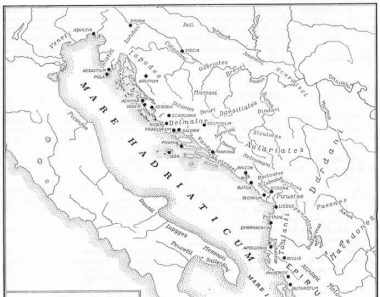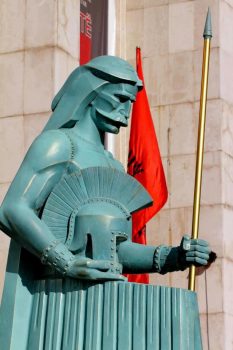According to the Greek mythology quoted by Apollodorus, Illyrius was a founder of Illyrian genus. Illyrius was a son of Phoenician Cadmus and his wife Harmonia. By the orders of his father Agenor (the king of the Phoenicia) Cadmus had to go to search his sister who was kidnapped by Zeus. Since Cadmus did not able to find his sister and after a time spending in wandering he finally stayed in Beotia in Greece where he found a city Thebes. After marrying Harmonia (daughter of the god of war Ares and goodness Aphrodite) by the order of the oracle, Cadmus went to Enchelei tribe where he became their king. As a king of the Encheleans, Cadmus within his wife Harmonia got a son Illyrius. Later Cadmus and Harmonia have turned into snakes. This was a short content of Greek myth about the term of Illyrians. In the religion of the Illyrians, the snake played a significant role. The main difficulty for historians was determination Illyrians origin and which tribe from the ancient sources could have considered as the Illyrians. According to the Bosnia-Herzegovinian archaeologist and historian Alojz Benac (1914-1992), the ethnic basis from which proto-Illyrians and later Illyrians evolved were developed from the period of the Iron Age when the people from the East started migration into the territory of Balkan. The other theory was represented by German linguist Gustaf Kossina and archaeologist Richard Pittoni who thought that Illyrians had strong connection from the Lusatian culture. Lusatian culture existed on the Later Bronze Age on todays territories of Poland, Germany, Slovakia and Czech Republic.
Illyrian territory
Greek writers who first tried to determine the borders of Illyrians did not have a clear idea of who were Illyrians and which areas they inhabited. The best source for determining the borders inhabited by the Illyrians was “Historia Romana” from Appian of Alexandria in written arount 2 century AD. According to Appian:
“Greeks consider the Illyrian tribes who lived above the Macedonia, Thrace from the borders of Chaonians and Thesprotians to the river Istros (Danube). This is the length of Illyria and the wide of Illyria is from the Macedonian and Thrace Hills to the Peon (or Panon) to the Ionean sea (or Adriatic sea) all the way to the beginning of the Alps. As the Greeks says, the length is five days long and the wide is thirty days long (probably by walk). But the Romans, since they measured the Illyrian territory they found it could be long 6.000 stadium (one stadium is approx 185 m or 607 ft) and wide 1.200 stadium.”
Based on the available historical sources Illyrians lived in the area from the northwestern border of Ancient Greek world to the Central Dalmatia including territories of todays Albania, Montenegro, the greater part of Bosnia and Herzegovina, Serbia and Kosovo. Ancient writers, epigraphic monuments written in Greek or Latin as well as inscriptions on Illyrian coins mentioned many Illyrian tribes who inhabited the western Balkan. On the far south along the Ionian coast lived the tribes: Atintanians, Chaonians, Molossians and others. They did not belong to the Illyrian tribes but the ancient writers did not considered them neither the Hellenes. North from them, lived Illyrian tribe Taulantii who initially inhabited the territory north of the river Drin. Their neighbors Enchelei also moved from north to south. Tribe Enchelei probably inhabited territory of the Bay of Kotor. Near the Ohrid Lake there was a tribe Dassaratae. From the south of Skadar Lake in todays central Albania lived tribe Albana and around Skadar Lake lived Labeates, Scritones and then towards the north lived Docleates, Melcumani, Derameistae, Ardiaei (also Vardiaei). Around the Neretva River lived Illyrian tribe Daorsi (Daorsei, Daversi). Their main center was the fortified city Daorson (near todays Stolac in Bosnia and Herzegovina).



Further in the north lived Illyrian tribe Dalmatae (also Dalmati, Delmati). They were known for the long-lasting wars against Romans. Dalmatae first lived in the interior of the land whose center was Delminium (todays Tomislavgrad in Bosnia and Herzegovina). In the 3th century BC they settled on the coast of the Adriatic Sea (todays territory of Dalmatia). From the river Krka along the coast of the Adriatic Sea lived Illyrian tribe Liburnians (also Liburni). In the fourth century BC Liburnians expanded to the territory of their neighbors Japodes (Iapydes) in todays Istria (Croatia). From the River Raša in the west to the River Reka (in Slovenia) all the way to the borders of Veneti, inhabited tribe Histri. It is difficult to say whether the Histri were Illyrians because they were mixed on Istrian peninsula with different ethnic elements. Tribe Dardani or Dardanians inhabited today’s southern and central Serbia to the west of the River Morava. Dardanians were also settled from the eastern part of the Morava river to the upper-stream of the Timok river including todays northern Macedonia and Kosovo. From the west of the Dardanians, inhabited Illyrian tribe Autariates (Autariatae) and Daesitiates. Autariates settled the territory of todays eastern Bosnia and Herzegovina all the way to the Morava River in Serbia. Deasitiates lived in todays central Bosnia and Herzegovina and their neighbors were Dindari, Deuri, Deretini, Maezaei and other smaller tribes.
Establishment of the first Illyrian states
The establishment of Greek colonies on the Adriatic coast had significant influence for the Illyrians. Greek colonization had consequences to the development of the Illyrian society, material and religious culture. Intensive trade relations between Greek colonies and Illyrians contributed to rapid expansion of the Illyrian culture and technology. In 627 BC, Korkyraeans (from the ancient Greek city on the island of Corfu) founded the city of Epidamnos (later the Roman Dyrrachium and todays Durrës in Albania) and in the 588 BC a colony Apollonia (near village Pojani in Albania) was established by Korkyraeans and Corinthians. In the interior of the Adriatic coast Greeks as colonists mostly appear from the 4th century BC. According to available historical sources, the oldest Illyrian state was the state of Encheleans. However, about Encheleans state was very little known and facts are based mostly on mythology about Cadmus and Harmonia. From very scarce sources Encheleans state were founded in the south of Illyria and they were fought against their neighbors Hellenes. According to Herodotus Encheleans attacked Delphic Oracle. The state of Encheleans reached its peak between 8th and 7th century BC wile in 6th century the state were in decline and finally fell in 4th century BC.



Parallel to the weakening of the Encheleans state, the tribe Taulantii began to strengthen their state. In the beginning, the main base of Taulantii was the place near Greek colony of Epidamnos. Their power later spread to an area that includes today’s Middle and Northern Albania. Taulantii were often fought against Macedonians and Greek colonies. Their ruler Glaucias in 7th century BC led the war against the king Argaeus of Macedonia. The state of Taulantii reached its peak in 4th century BC. Their power at the end of 4th century began to decline rapidly. Strengthening the Macedonian state and invasions of the Celts in the territory of Illyrians has changed the relations between the forces in the Western Balkans. Philip II of Macedonia gathered a large army and defeated the Illyrian king Bardyllis in 358 BC. Son of the Philip II Macedon, Alexander the Great continued to fought against Illyrians and he defeated the Illyrian king of Taulantii Glaukias and Encheleans king Cleitus. The struggles of Encheleans and Taulantii against the Macedonians persisted in the following period, which these issues allowed to strengthen other Illyrian tribes on Balkan peninsula.
References:
- Gustav Zippel, Die Römische Herrschaft in Illyrien Bis Auf Augustus, Leipzig 1877.
- Alojz Benac, Prediliri, Protoiliri, Prailiri, Simpozijum o teritorijalnom i hronološkom razgraničenju Ilira u prahistorijsko doba, Sarajevo 1964, 59-94.
- Alekasndar Stipčević, Iliri, Zagreb 1989.
- Salmedin Mesihović, Ilirike, Sarajevo 2013.
